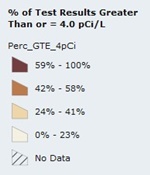Janesville Radon Testing and Mitigation

 Janesville, Wisconsin, is situated in southern Wisconsin, just above the Illinois state line. The city of Janesville is the county seat and the largest city in Rock County. The Janesville metropolitan area has a population of approximately 65,000.
Janesville, Wisconsin, is situated in southern Wisconsin, just above the Illinois state line. The city of Janesville is the county seat and the largest city in Rock County. The Janesville metropolitan area has a population of approximately 65,000.
As the map to the right shows, three zip codes in the Janesville area have radon levels among the highest in the state: 53546, 53505, 53114 (the dark brown area). According to the EPA’s records on radon test results, 59% to 100% of homes in these zip codes have radon test results higher than or equal to 4 pCi/L (picocuries per liter).
Don't think that just because you're not in those three zip codes you're safe. Almost all of the area surrounding Janesville is also at high risk of elevated radon levels. The lighter brown areas indicate 42% to 58% of homes tested at 4 pCi/L of radon or greater.
Why Are Radon Levels in Janesville So High?
No one really knows why homes in Janesville, as well as some other areas of the state, have higher radon levels than others. Radon, a colorless, odorless, highly radioactive gas, is a byproduct of uranium ore in the earth. Uranium is found throughout the world, and radon is virtually everywhere—even outdoors. The problem is that it accumulates in houses and reaches dangerous levels, particularly newer homes, which are better sealed up against the weather.
Although the EPA has identified 4 pCi/L as the level at which action should be taken to reduce radon levels, it’s important to keep in mind that radon is a radioactive gas. So, ultimately, there is no such thing as a “safe” level of radon. In virtually all cases, though, radon mitigation systems can bring alarmingly high indoor radon levels down to acceptable levels—i.e. levels considerably below 4 pCi/L.
If There Is No Safe Level Of Radon, How Can A Radon Mitigation System Make A Home Safer?
When you look at the map of Rock County on this page, you can clearly see almost the entire area is at risk of elevated radon levels—minus the southwest corner, which for some reason has only 0% to 23% of test results coming in at or greater than 4 pCi/L. What you don’t see from this map, though, are the homes that tested way above the 4 pCi/L level.
Lifetime Radon Solutions has tested many homes in the Rock County area, and the results vary widely. When we come across a home with levels of 15 to 20 pCi/L, as we have, it is apparent to even the most skeptical homeowner that it would probably be a good idea to have a mitigation system installed. While it is rare to get a home’s radon levels as low as they are outdoors (.4pCi/L on average), it is not uncommon to bring the radon level down to 2 pCi/L, and often even lower.
Radon Testing Advised For All Homes In Rock County.
 According to the World Health Organization, your risk of lung cancer from radon exposure rises 16% for every 2.7 pCi/L increase in radon exposure. This alone should be pretty good motivation to have your home tested. Additionally, anyone who spends time in their basement rooms should definitely be concerned, since radon levels are highest in the lowest level of a house. If you have a finished basement with bedrooms where children sleep or a downstairs entertainment room where your family spends a lot of time, you probably want to know how much radon exposure you’re getting while in the basement.
According to the World Health Organization, your risk of lung cancer from radon exposure rises 16% for every 2.7 pCi/L increase in radon exposure. This alone should be pretty good motivation to have your home tested. Additionally, anyone who spends time in their basement rooms should definitely be concerned, since radon levels are highest in the lowest level of a house. If you have a finished basement with bedrooms where children sleep or a downstairs entertainment room where your family spends a lot of time, you probably want to know how much radon exposure you’re getting while in the basement.
Schedule A Radon Test For Your Janesville Area Home Today.
Getting a radon test done is easy. Our licensed radon testing technicians will identify the lowest area of your home and place two electronic testing devices in the area. After 48 hours, they’ll come back to pick up the devices and analyze the data. In most cases, you’ll have the results of your radon test that very day.
The only thing you need to do during the 48-hour period is keep your house closed up as much as possible: No open windows, no exhaust fans, and only open the entry door when necessary. You will also need to leave the testing devices undisturbed where they are.
 262-955-5701
262-955-5701




